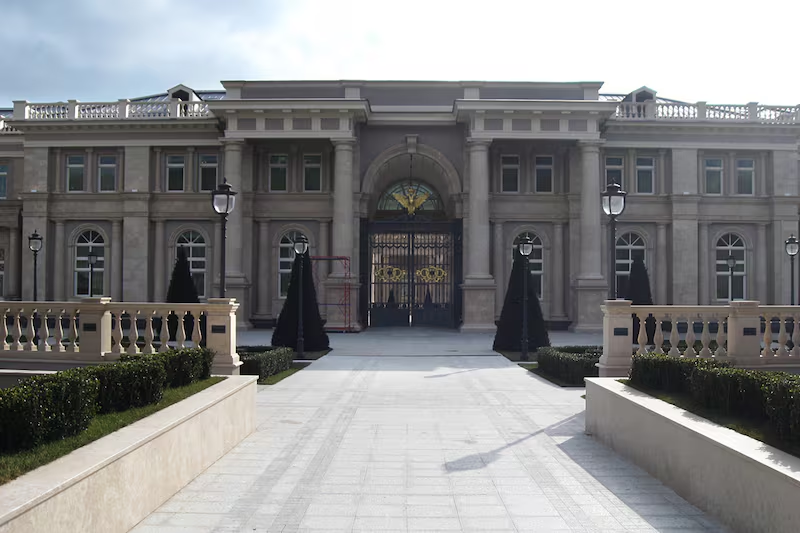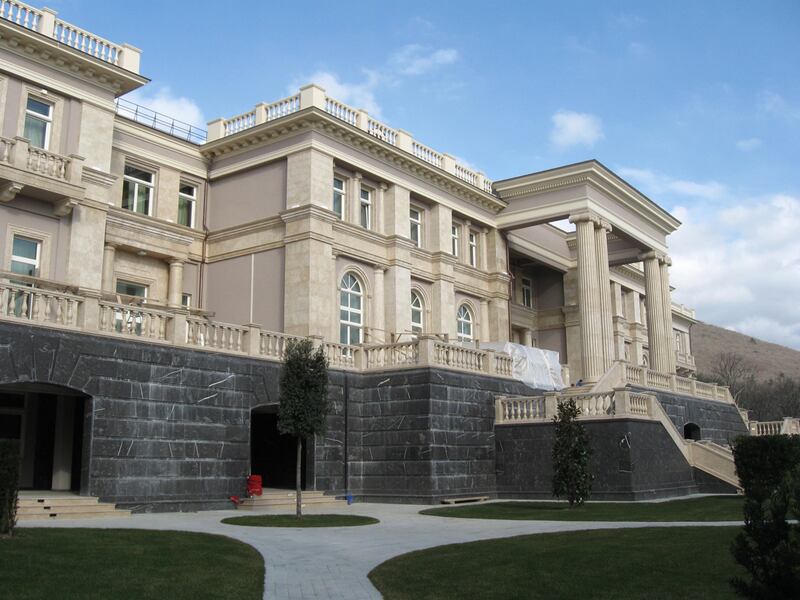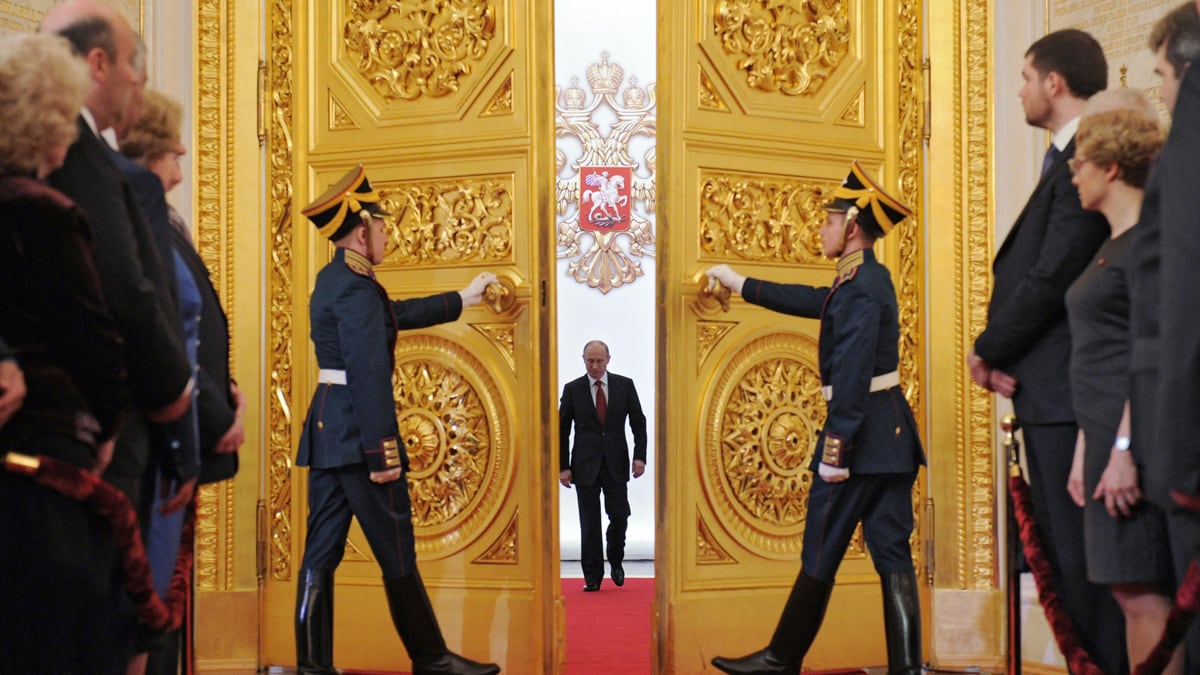On a recent morning, in the village of Praskoveyevka, located on the northern coast of Russia's Black Sea, a few hours’ drive from Sochi, host of the 2014 Winter Olympics, a group of activists—some in bathing suits, others in the nude—went for a swim at a public beach. Their goal: to get a closer look at an extravagant mansion, set in the middle of a nearby forest. The house, with its black, iron gate and Soviet era façade, looked surreal, as if someone had transported it from Moscow and dropped it in the middle of nowhere.
As the activists swam toward the mansion, two security guards in black uniforms spotted them from a distance. Soon a motor boat with more men in black appeared, its engine growling ominously as it sped over the water. Hoping to make an escape, activists swam toward a dredge with a “Spetcstroi Rossii” sign on its side, for the special state construction company of the Russian government. Yet as the boat approached, the guards realized that some of the activists were naked. Disgusted, they gave up pursuit. On that day at least, they had no desire to take nude prisoners; instead they simply ordered them to return to the shore. "Tell us when you plan to visit us next time," one of the guards said snidely.
For months, the activists have been camping in the woods near the mansion, sneaking past the guards and the "No Trespassing" signs to photograph the massive home. Last week, they posted photos online of its lush courtyard and Tsar-like bedroom on their popular blog. On paper, the house and the surrounding 40 acres are owned by Indocopas, a mysterious company without a Web site or even a phone number. Yet two years ago, a disgruntled investor named Sergei Kolesnikov, who is not involved in the project, sent a public letter to then-President Dmitry Medvedev claiming that state money was being used to build the private mansion on state-owned land. Its real owner, he said: current President Vladimir Putin. (Department for Presidential Affairs did not return calls for comment).
Since then, more people have come forward alleging that the construction of Putin's Palace on the Black Sea, as it's commonly known, and the construction of summer homes belonging to other Russian luminaries, have involved the illegal use of state funds and the violation of environmental regulations. Meanwhile, Russia's growing political opposition has cast a spotlight on these extravagant mansions, which have come to be viewed as symbols of official corruption. "Historically, each Russian tsar built himself a new palace," said Andrei Petrov, a researcher for Green Peace in Moscow. "But our current leaders' appetites seem wild [by comparison]. They are destroying the most beautiful parts of the country."
The trend allegedly began in 2001, when President Putin decided to turn Strelna Palace outside of St. Petersburg into one of his summer homes (though unlike the Black Sea mansion, this one is open to the public). By 2005, a building rush had begun, critics say, as other top Russian officials sought similarly posh seasonal residences. Today, activists count as many as 26 new mansions across the country with picturesque views of the ocean or nearby rivers or lakes—all allegedly built by oligarchs or politicians on protected public land using Russian tax dollars. "We find Putin's palaces in the most beautiful spots of the Russian federation, from Siberia's Altai, where he has a huge villa, to my hometown on the Volga River," said Sergei Mitrokhin, the leader of the opposition Yabloko Party.

New mansions continue to spring up along the coast. Not far from Putin's alleged home, in Divnomorsky, is another enormous white stone residence, set on a 49 acres of land that opposition leaders say belongs to Patriarch Kirill, the leader of Russia's Orthodox Church. (Kirill’s office denies this, saying it is a southern administrative center for the church.) Photographs of the building, which were reviewed by The Daily Beast, show a house with an onion-like dome awkwardly stuck on top of multiple verandas. Greek columns and large arched windows decorate the front.
Determining precisely who owns these mansions is difficult. Public documents show that the Russian government owns some of them, but others appear to belong to private companies, which activists say are little more than fronts for politicians and other luminaries. Robert Schlegel, a deputy in Putin's ruling United Russia party said that it's "close to impossible" to receive an official comment explaining details about Putin's mansions, or anyone else's for that matter, as "nobody in the Kremlin's press service has authority to talk about that."
This lack of transparency has sparked a public backlash in places like Krymsk, a city in Russia's Krasnodar region on the country's northern Black Sea coast. After floods recently killed dozens and left thousands homeless in the area, the mansions have come to be viewed as stark reminders of rampant inequality and official corruption in the country. One such home, in the city of Sochi, used to be a sanitarium. But in September of 2010, the Kremlin’s administration reportedly took it over, fired its 300 employees and asked its 750 patients to find other places for treatment. "Even Stalin did not build himself huge palaces," said one of the sanitarium's former managers, who spoke on the condition of anonymity for fear of repercussions from the government. "Today's leaders have no shame."
Aside from the alleged misuse of public dollars, some critics are upset that they no longer have the same access to what was once public land. For decades, nudists frequently came to sunbathe along the pristine six mile-long beach outside Putin's alleged home in Praskoveyevka. Now their access is restricted. "Moscow oligarchs treat people like common fools," said Viktor Gavrilov, a local park ranger. Suren Ghazaryan, one of the activists who frequently takes photos of the mansion, agreed. "What an absurd world we live in!" he said. "Sometimes I think I see Putin, also naked, strolling along the beach towards us in black sunglasses!"

Over the past six months, Ghazaryan and other critics have begun to fight back. Green Peace reports that activists have managed to slow the construction of two luxurious homes—Lunnaya Poliana, a mountain resort formally owned and financed by the Putin administration, and Bolshoi Utrish, a residential complex reportedly owned by Medvedev. Yet a bevy of complaints about these mansions, lodged to Russia's ministry of environment by opposition leaders and environmental activists have largely been ignored. And sometimes, exposing just who owns these homes comes with a cost. Last year, two local environmentalists were sentenced to three years of probation for writing "Sasha is a thief" on the fence outside a home that Alexander Tkachev, the governor of Krasnodar, allegedly built on state-protected land. The Tkachev administration denies that the house belongs to the governor.
In the end, however, critics are confident that by ignoring the backlash against these mansions, the regime and its backers are making the same lavish mistakes that their predecessors did roughly a century ago, in the leadup to the Bolshevik Revolution. "Putin's policy is short-sighted," said Gennady Gudkov, the deputy of the Duma, the lower house of Russia's parliament. "Sooner or later, history is going to repeat itself."
Reporting for this piece was made possible by a grant from the Pulitzer Center on Crisis Reporting.






